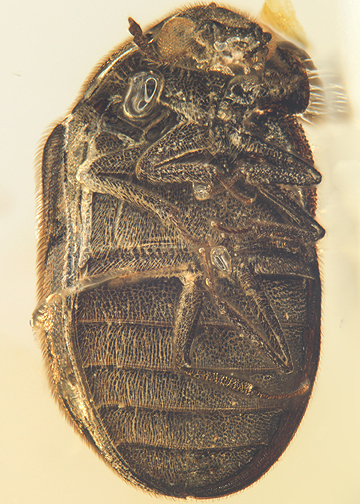Abstract
Various dermestids have been reported from mid-Cretaceous Burmese amber (e.g., Deng et al., 2017; Háva & Damgaard, 2017; Háva, 2020, 2021). Among them, Attagenus burmiticus Cai et al. was the first adult described from this deposit (Cai et al., 2017). This fossil was originally attributed to the extant genus Attagenus in subfamily Attageninae. However, an important character was overlooked when they made this placement. Attagenus burmiticus has metacoxae meeting elytral epipleura laterally, which are unknown in any other Dermestidae except subfamily Orphilinae (Háva, 2004; Lawrence & Ślipiński 2005). In this study, we re-examine the holotype of A. burmiticus and transfer it into genus Nothattagenus Li & Cai gen. nov. in Orphilinae, as Nothattagenus burmiticus comb. nov.
References
- Cai, C.Y., Háva, J. & Huang, D.Y. (2017) The earliest Attagenus species (Coleoptera: Dermestidae: Attageninae) from Upper Cretaceous Burmese amber. Cretaceous Research, 72, 95–99. https://doi.org/10.1016/j.cretres.2016.12.018
- Cai, C.Y. & Huang, D.Y. (2014) The oldest micropepline beetle from Cretaceous Burmese amber and its phylogenetic implications (Coleoptera, Staphylinidae). Naturwissenschaften, 101 (10), 813–817. https://doi.org/10.1007/s00114-014-1221-z
- Deng, C.S., Ślipiński, A., Ren, D. & Pang, H. (2017) New Cretaceous carpet beetles (Coleoptera: Dermestidae) from Burmese amber. Cretaceous Research, 76, 1–6. https://doi.org/10.1016/j.cretres.2017.04.004
- Fu, Y.Z., Li, Y.D., Su, Y.T., Cai, C.Y. & Huang, D.Y. (2021) Application of confocal laser scanning microscopy to the study of amber bioinclusions. Palaeoentomology, 4 (3), 266–278. https://doi.org/10.11646/palaeoentomology.4.3.14
- Háva, J. (2004) World keys to the genera and subgenera of Dermestidae (Coleoptera), with descriptions, nomenclature and distributional records. Acta Musei Nationalis Pragae, Series B, Natural History, 60, 149–164. https://doi.org/10.25221/fee.420.2
- Háva, J. (2010) Nuevos datos sobre Orphilus beali Zhantiev para la Península Ibérica (Coleoptera: Dermestidae). Arquivos Entomolóxicos, 3, 99–100.
- Háva, J. (2014) A new species of the genus Ranolus (Blair, 1929) from Thailand (Coleoptera: Dermestidae: Orphilinae: Ranolini). Studies and Reports, Taxonomical Series, 10, 403–408.
- Háva, J. (2015) A new Orphilodes Lawrence & Ślipiński, 2005 from Papua New Guinea (Coleoptera: Dermestidae: Orphilinae). Arquivos Entomolóxicos, 14, 223–226.
- Háva, J. (2020) To the knowledge of the subfamily Attageninae (Coleoptera: Dermestidae) from Cretaceous Burmese amber. Far Eastern Entomologist, 420, 14–19. https://doi.org/10.25221/fee.420.2
- Háva, J. (2021) Two new genera and species of Dermestidae (Coleoptera) from Cretaceous Burmese amber. Euroasian Entomological Journal, 20, 343–345. https://doi.org/10.15298/euroasentj.20.6.08
- Háva, J. & Damgaard, A.L. (2017) Attagenus lundi sp. nov. from Cretaceous Burmese amber (Coleoptera: Dermestidae: Attageninae). Studies and Reports, Taxonomical Series, 13, 303–306. https://doi.org/10.1101/2021.09.22.461358
- Háva, J. & Kadej, M. (2014) Contribution to knowledge of the Dermestidae (Coleoptera) from Afghanistan with description of three new species. Florida Entomologist, 97, 1414–1423. https://doi.org/10.1653/024.097.0416
- Háva, J. & Kalík, V. (2005) A contribution to knowledge of the tribe Attagenini (Coleoptera: Dermestidae: Megatominae) from the Malayan subregion. Acta Musei Moraviae, Scientiae Biologicae (Brno), 90, 209–214.
- Háva, J. & Lawrence, J. (2017) Contribution to the genus Ranolus Blair (Coleoptera: Dermestidae: Ranolini), with new synonymy and combinations. Australian Entomologist, 44, 103–104.
- Kiselyova, T. & McHugh, J.V. (2006) A phylogenetic study of Dermestidae (Coleoptera) based on larval morphology. Systematic Entomology, 31, 469–507. https://doi.org/10.1111/j.1365-3113.2006.00335.x
- Lawrence, J.F. & Ślipiński, A. (2005) Three new genera of Indo-Australian Dermestidae (Coleoptera) and their phylogenetic significance. Invertebrate Systematics, 19, 231–261. https://doi.org/10.1071/IS04033
- Motyka, M., Kusy, D., Háva, J., Jahodářová, E., Bílková, R., Vogler, A.P. & Bocak, L. (2022) Mitogenomic data elucidate the phylogeny and evolution of life strategies in Dermestidae (Coleoptera). Systematic Entomology, 47, 82–93. https://doi.org/10.1111/syen.12520
- Zahradnik, P. & Háva, J. (2014) Catalogue of the world genera and subgenera of the superfamilies Derodontoidea and Bostrichoidea (Coleoptera: Derodontiformia, Bostrichiformia). Zootaxa, 3754, 301–352. https://doi.org/10.11646/zootaxa.3754.4.1
- Zhou, Y.L., Nicholls, J., Liu, Z.H., Hartley, D., Szito, A., Ślipiński, A. & Zwick, A. (2022) Molecular phylogeny of Dermestidae (Coleoptera) reveals the polyphyletic nature of Trogoderma Latreille and the taxonomic placement of the Khapra Beetle Trogoderma granarium Everts. Authorea. [Posted on April 08, 2022] https://doi.org/10.22541/au.164943190.06031321/v1


